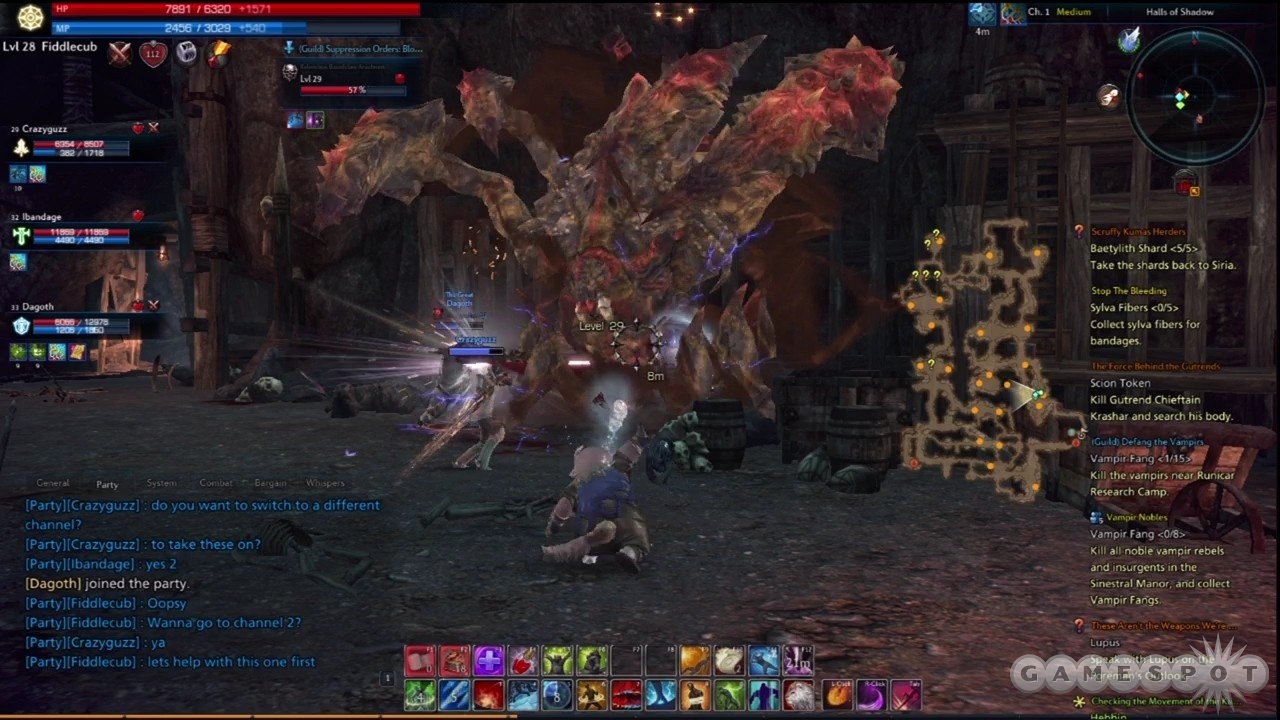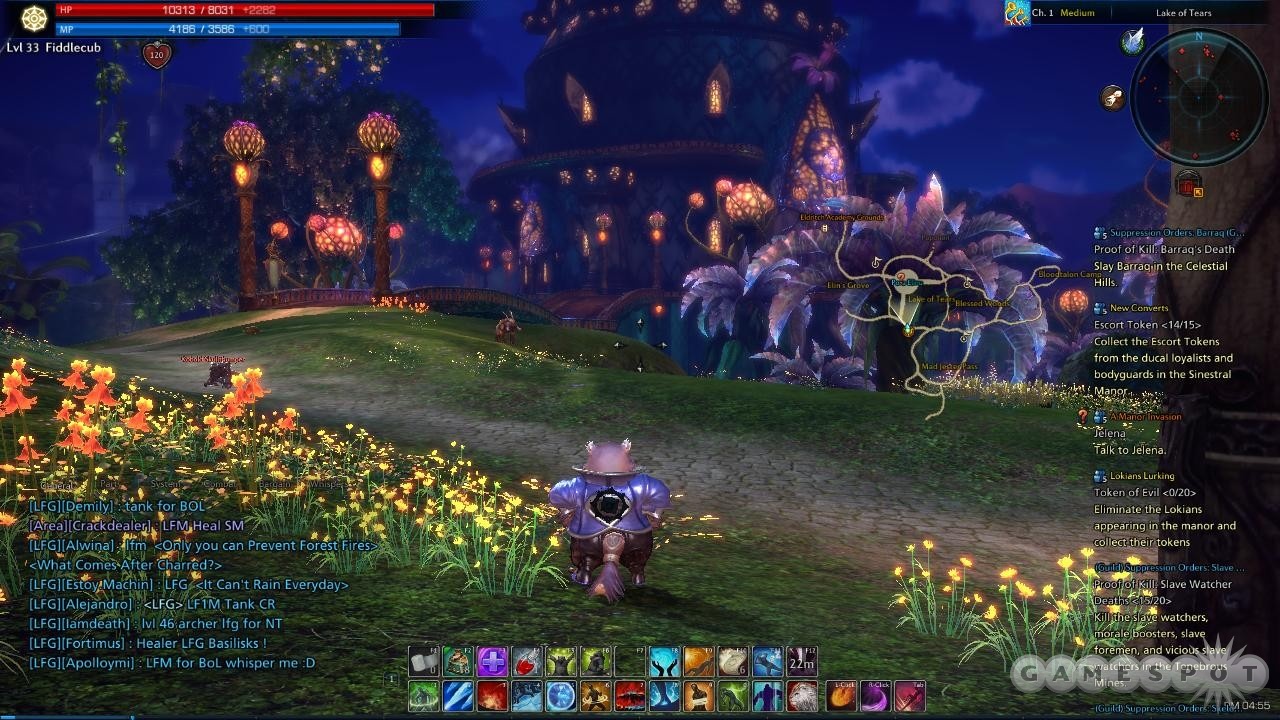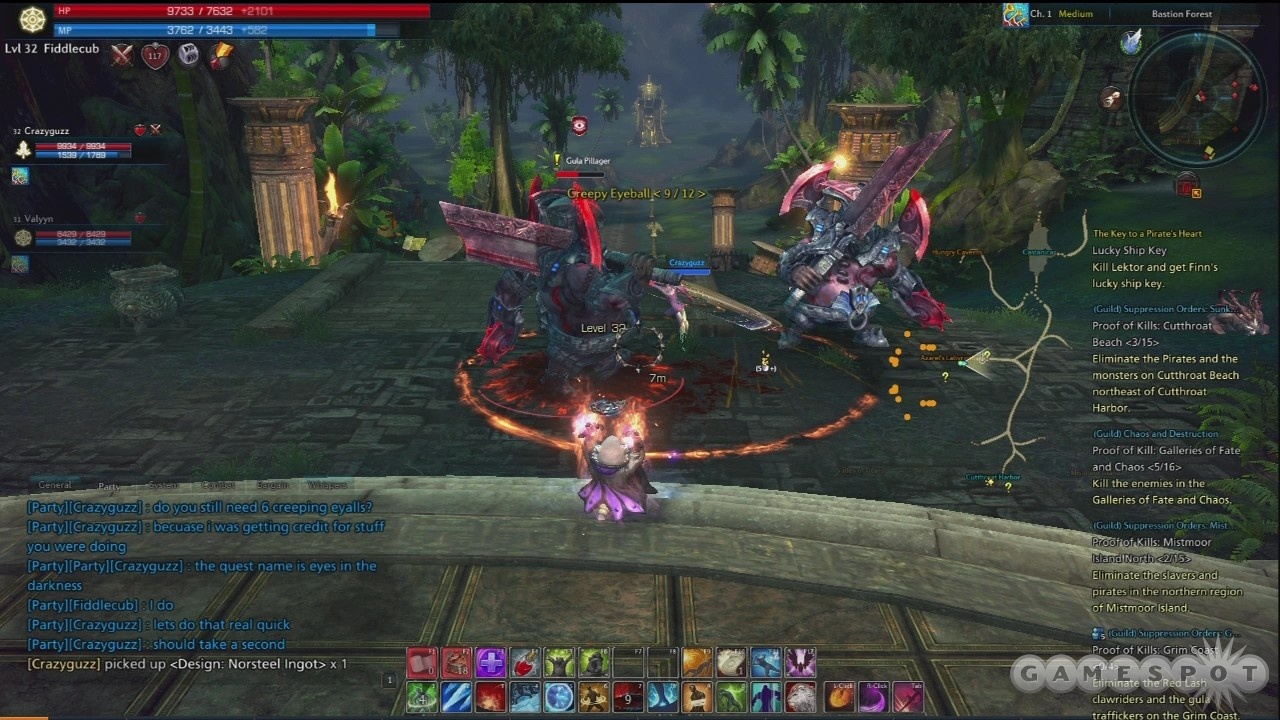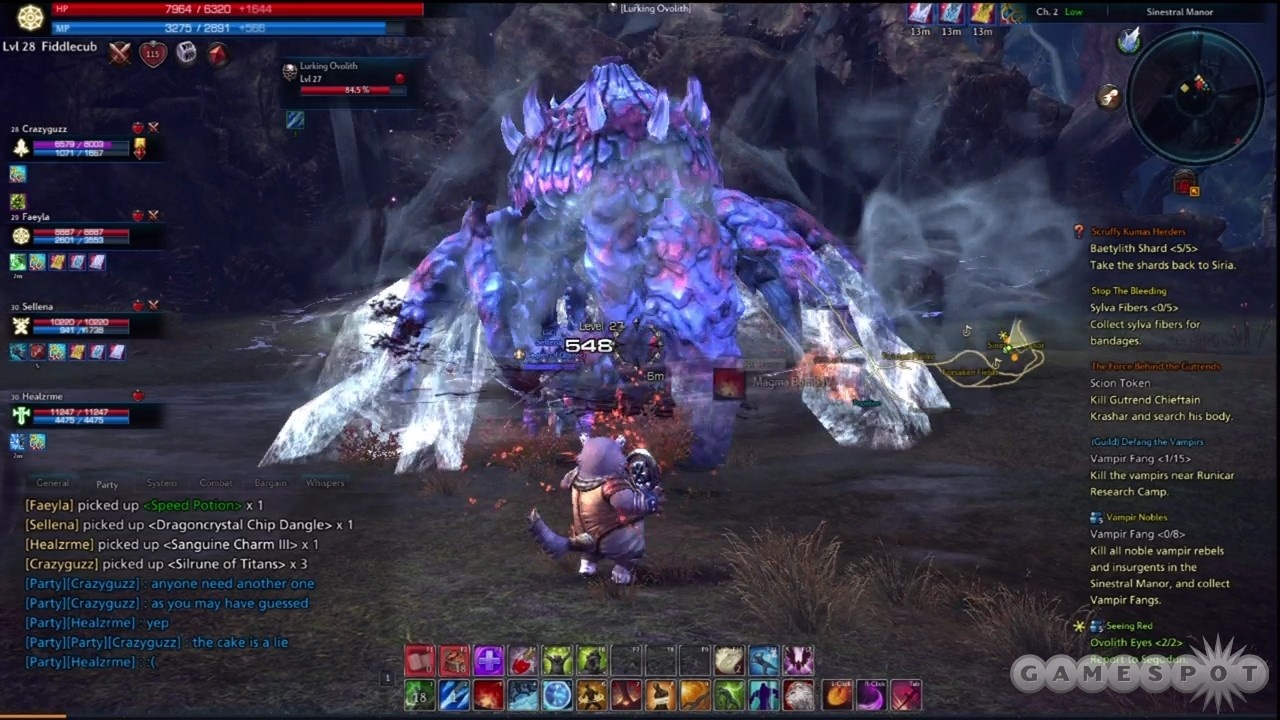In many ways, Tera is a whole lot like other massively multiplayer role-playing games. You team up with other players, fight monsters, level up, earn new gear, and so on. It is, in fact, a very traditional online fantasy adventure in most respects but one: its action. And that action is so smooth, so immediate, and so enjoyable that it's likely to keep you invested in Tera, even as you skip from one quest to the next, ferrying messages between characters standing 20 feet from each other. Generic questing aside, Tera is a well-executed game: it's easy on the eyes, smooth under the fingers, and remarkably stable.
So what is it about the combat that makes it so good? For one, you needn't worry about choosing your target before firing off the usual barrage of sword slashes and fireballs that automatically find their mark. Instead, you hover your targeting reticle over your target and swing, or stab, or cast. Sure, some attacks are homing attacks, but generally, if you miss, you don't do any damage. For example, should you release a slow-moving blastball and the big hulk in front of you lumbers away, you're out of luck. Tera feels more like a third-person action game than most MMOGs--you don't even need to hold a mouse button to engage mouselook.
As a result, you feel connected to the action: your key presses and mouse maneuvers translate almost immediately to the screen. Yes, there are ability cooldowns, and you have to wait for animations to complete. But there is a sense of agility to the combat that's rare in the genre. Big creatures bound around and exhale toxic fumes, while you and your adventuring party hammer on them when you aren't busy dodging, guarding, and getting into the most effective position. The biggest creatures are known as BAMs (that is, big-ass monsters), and facing one is a rush. One such monster is the ovolith, a giant spider creature that rolls across the landscape like a spinning top, bounds into the air and lands with a smash, and hammers the ground in the same way a data entry expert hammers on a keyboard. Facing one with three or four friends is a riot. You must aim your attacks and stay alert, and you receive an indication of damage done only when your ice blast meets flesh--not before. How wonderful it is, this rare feeling that you are performing daring battlefield feats, rather than simply inputting commands and watching them play out onscreen.

It's a shame that there is an hours-long lull before you see Tera at its best. The tutorial prologue is great, in part because it starts you at level 20, gives you a few interesting abilities, and pits you against a couple of towering ogres. But when it's over, you're off to the island of newcomers, where you start from scratch at level one with a paltry couple of skills. From here, you're sent on a series of quests that can politely be called "standard," though "monotonous" is a better term. Most RPGs have you going off to kill stuff, collect stuff, and pass on information to those who need it, of course. But varied pacing, strong mission dialogue, and other contextual elements can make for fun, diverse questing. Sadly, Tera's quests are as dry as its own Shara Desert. Every outpost is having some kind of problem with local creatures. Someone has always gone missing, and you have to go find them. Quest givers want you to take information to people standing within earshot. It's all so very tired.
There is a story tying all of it together, starting with a demon invasion and the search for a missing war hero. The writing isn't on Fallen Earth or Age of Conan levels of excellence, nor will you shape the story as you play in the style of Star Wars: The Old Republic. Yet developer BlueHole Studio tries to sweep you up in the process, punctuating certain story quests with excellent real-time cutscenes featuring your own character. Story arcs often culminate in instanced battles, with you and maybe your teammates fending off a sequence of attackers, or taking on a nasty boss demon. These sequences do a great job of keeping the mundane side quests from wearing on you.

Considering the blandness of the quests, Tera keeps you involved in the proceedings. Of course, much of this has to do with the combat. But the world design can take much of that credit. Granted, there's a certain inconsistency to the Tera universe. You can play as a horned, ferocious-looking Castanic, or as a hypercute foxgirl from the Elin race. The noble flesh mountains known as the Baraka cut impressive figures--particularly when standing next to a Popori, which looks like a portly panda. This bizarre and eclectic mix of fantasy figures comes across as disjointed at first, but it ultimately comes together. That's at least in part because the character diversity is matched by environmental diversity. The tropical landscapes at Cutthroat Harbor couldn't be more different from the enchanted city of Pora Elinu.
And what a place it is. A dark baroque tower rises in the center, the golden light behind stained glass windows acting like beacons, drawing you closer. In the creepy Forsaken Fields, gnarled vines warn you away, as if the sinister vampires in tuxedos and top hats weren't already doing so. Tera is a great-looking game with dozens of distinct regions waiting to be explored. It also runs extremely well, deftly balancing beauty with performance. In fact, from top to bottom, Tera performs wonderfully. It isn't bug-free: there are some quest glitches and occasional spots of lag, and the chat window has a bad habit of deleting chat logs. But Tera is yet another signal to other massively multiplayer online game developers that it isn't OK to release a hobbled game suffering from major bugs and wide content gaps.

Not that Tera is fully loaded where content is concerned. There are plenty of quests to perform (you never grind for grinding's sake), but if you seek player-versus-player excitement, you'll want to sit this one out. There are the usual one-on-one duels, as well as team-versus-team deathmatches that function much like duels do, albeit with two teams rather than two players. Deathmatches require two willing groups; they don't take place in structured battle arenas, and there is no matchmaking, and thus no one ever plays deathmatch. If you like to deliver cruel open-world savageness to unsuspecting travelers, you can choose a PVP server, where you may also take part in guild-on-guild battles. But a more structured battlefield is sorely needed for players on all servers. The good news is that battlegrounds are planned for later this year. For now, however, it does feel as though something's missing, considering most modern MMOGs offer an easy way to fight other players without worrying that some high-level executioner is ready to intrude on your questing.
If you're in it for the camaraderie, however, Tera is for you. Group dungeons are a lot of fun. In Sinestral's manor, for example, crimson horned behemoths stand in your way, but with a talented party, you should make it past them unscathed. The final clawed horror might give you a hard time of it though, as it madly marches forward and twirls about in anger. Again, it all comes down to the combat: you can't rely on targeting these meanies and firing a bunch of arrows with abandon. You have to know how to time your swings, be ready to block or dodge, and cast the lengthiest spells only when you know you've got the time to spare. (Nothing is more disheartening than having a creature jump out of the effective area of your spell.) No matter which group role you prefer, there's a class you'll enjoy. Ranged magic, hardy tanks, healers, support classes--it's all covered, and even better, all classes are available to all races.
Once you get a handle on which attacks serve you best, you can further customize skills using glyphs. Tera doesn't have a traditional talent tree. Instead, you purchase glyphs and use them to enhance your existing skills. But you have limited glyph points, and certain glyphs cost more points than others, so you must choose which glyphs you want to equip. You can also enhance weapons by slotting in crystals, and even enchant them. And there are also typical gathering and crafting systems that allow you to collect raw materials and assemble them into better gear. The player economy is active, so whether you prefer to make and sell a fancy magical disc or are in the market for one, the player trade brokerage is a valuable tool.
Other features reveal their nature as greater numbers of players gain levels, such as a political system in which guild leaders campaign to lead a province. Otherwise, Tera has an air of the expected. Structurally, it's not much different from any other online fantasy RPG: you level up and move on to new areas, completing quests until you're ready for the next. What a difference an excellent combat system makes, and in Tera's case, it elevates an ordinary game into something more delightful than you would have expected from an MMOG. It might be all about the fight, but when the fight is this much fun, you want to keep your axe arm swinging and your mouse finger clicking.
